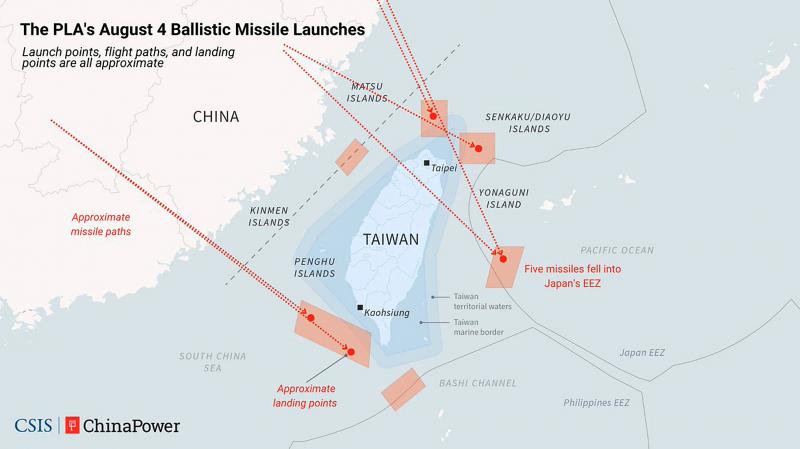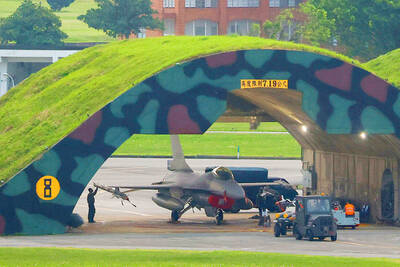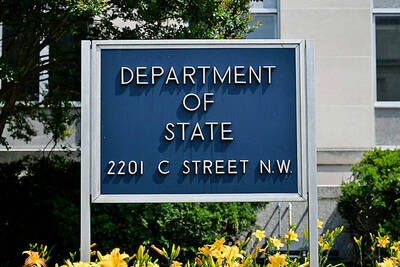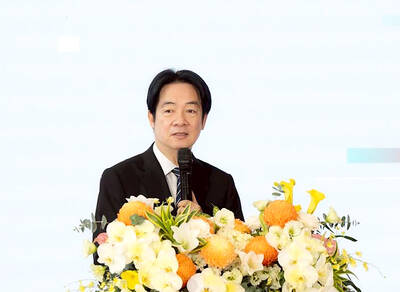As China waged extensive military exercises off Taiwan, a group of US defense experts in Washington was focused on their own simulation of an eventual — but for now entirely hypothetical — US-China war over the nation.
The unofficial what-if game is being conducted on the fifth floor of an office building not far from the White House, and it posits a US military response to a Chinese invasion in 2026. Even though the participants bring a US perspective, they are finding that a US-Taiwan victory, if there is one, could come at a huge cost.
“The results are showing that under most — though not all — scenarios, Taiwan can repel an invasion,” said Mark Cancian, a senior adviser at the US Center for Strategic and International Studies (CSIS), where the war games are being held. “However, the cost will be very high to the Taiwanese infrastructure and economy and to US forces in the Pacific.”

Photo: Screengrab from CSIS Twitter
In sessions that are to run through next month, retired US generals and navy officers and former Pentagon officials hunch like chess players over tabletops along with analysts from the CSIS think tank. They move forces depicted as blue and red boxes and small wooden squares over maps of the western Pacific and Taiwan. The results are to be released to the public in December.
The not-necessarily-so assumption used in most of the scenarios: China invades Taiwan to force unification, and the US decides to intervene heavily with its military. Also assumed but far from certain: Japan grants expanded rights to use US bases on its territory, while stopping short of intervening directly unless Japanese land is attacked.
Nuclear weapons are not used in the scenarios, and the weapons available are based on capabilities the nations have demonstrated or have concrete plans to deploy by 2026.
In 18 of the 22 rounds of the game played to this point, Chinese missiles sink a large part of the US and Japanese surface fleet and destroy “hundreds of aircraft on the ground,” said Cancian, a former White House defense budget analyst and retired US Marine. “However, allied air and naval counterattacks hammer the exposed Chinese amphibious and surface fleet, eventually sinking about 150 ships.”
“The reason for the high US losses is that the United States cannot conduct a systematic campaign to take down Chinese defenses before moving in close,” he said.
“The United States must send forces to attack the Chinese fleet, especially the amphibious ships, before establishing air or maritime superiority,” he said.
“To get a sense of the scale of the losses, in our last game iteration, the United States lost over 900 fighter/attack aircraft in a four-week conflict. That’s about half the [US] Navy and Air Force inventory,” he said.
Taiwan’s defense capabilities are an especially important part of the calculations, because its forces would be responsible for blunting and containing Chinese landings from the south — a scenario played out in the simulation.
“The success or failure of the ground war depends entirely on the Taiwanese forces,” Cancian said. “In all game iterations so far, the Chinese could establish a beachhead, but in most circumstances cannot expand it. The attrition of their amphibious fleet limits the forces they can deploy and sustain. In a few instances, the Chinese were able to hold part of the island, but not conquer the entire island.”

MISINFORMATION: The generated content tends to adopt China’s official stance, such as ‘Taiwan is currently governed by the Chinese central government,’ the NSB said Five China-developed artificial intelligence (AI) language models exhibit cybersecurity risks and content biases, an inspection conducted by the National Security Bureau (NSB) showed. The five AI tools are: DeepSeek, Doubao (豆包), Yiyan (文心一言), Tongyi (通義千問) and Yuanbao (騰訊元寶), the bureau said, advising people to remain vigilant to protect personal data privacy and corporate business secrets. The NSB said it, in accordance with the National Intelligence Services Act (國家情報工作法), has reviewed international cybersecurity reports and intelligence, and coordinated with the Ministry of Justice Investigation Bureau and the National Police Agency’s Criminal Investigation Bureau to conduct an inspection of China-made AI language

BOOST IN CONFIDENCE: The sale sends a clear message of support for Taiwan and dispels rumors that US President Donald Trump ‘sold out’ the nation, an expert said The US government on Thursday announced a possible sale to Taiwan of fighter jet parts, which was estimated to cost about US$330 million, in a move that an expert said “sends a clear message of support for Taiwan” amid fears that Washington might be wavering in its attitude toward Taipei. It was the first announcement of an arms sale to Taiwan since US President Donald Trump returned to the White House earlier this year. The proposed package includes non-standard components, spare and repair parts, consumables and accessories, as well repair and return support for the F-16, C-130 and Indigenous Defense Fighter aircraft,

CHECKING BOUNDARIES: China wants to disrupt solidarity among democracies and test their red lines, but it is instead pushing nations to become more united, an expert said The US Department of State on Friday expressed deep concern over a Chinese public security agency’s investigation into Legislator Puma Shen (沈伯洋) for “secession.” “China’s actions threaten free speech and erode norms that have underpinned the cross-strait ‘status quo’ for decades,” a US Department of State spokesperson said. The Chongqing Municipal Public Security Bureau late last month listed Shen as “wanted” and launched an investigation into alleged “secession-related” criminal activities, including his founding of the Kuma Academy, a civil defense organization that prepares people for an invasion by China. The spokesperson said that the US was “deeply concerned” about the bureau investigating Shen

‘TROUBLEMAKER’: Most countries believe that it is China — rather than Taiwan — that is undermining regional peace and stability with its coercive tactics, the president said China should restrain itself and refrain from being a troublemaker that sabotages peace and stability in the Indo-Pacific region, President William Lai (賴清德) said yesterday. Lai made the remarks after China Coast Guard vessels sailed into disputed waters off the Senkaku Islands — known as the Diaoyutai Islands (釣魚台) in Taiwan — following a remark Japanese Prime Minister Sanae Takaichi made regarding Taiwan. Takaichi during a parliamentary session on Nov. 7 said that a “Taiwan contingency” involving a Chinese naval blockade could qualify as a “survival-threatening situation” for Japan, and trigger Tokyo’s deployment of its military for defense. Asked about the escalating tensions